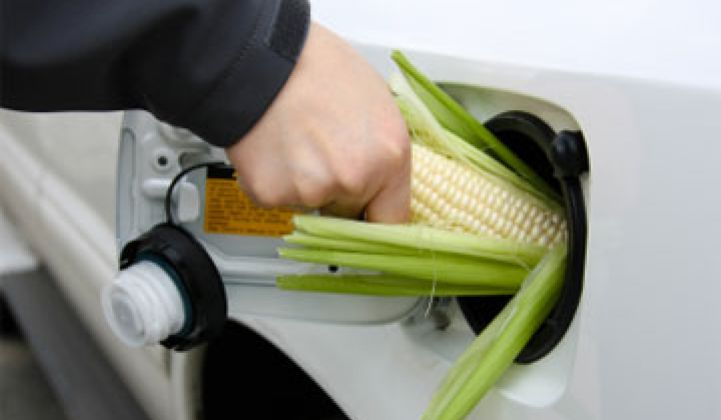Today, the Environmental Protection Agency (EPA) increased the amount of ethanol that it allows to be blended in certain cars from 10% to 15% (E15). This change applies only to light fleet automobiles with the model year 2007 and later, representing about 20% of the U.S. fleet. The EPA is currently finalizing its testing of model years 2001-2006 and is expected to make an announcement in late November on whether these vehicles are safe for E15.
Why did the EPA revise the 'blend wall'?
First-generation ethanol is the dominant biofuel in the United States, accounting for roughly 95% of the domestic biofuel market. Because ethanol is largely produced via corn fermentation, the U.S. will utilize approximately one-third of its corn crop to produce an estimated 12.6 billion gallons of ethanol in 2010.
Given that ethanol only contains two-thirds the energy density of gasoline, ethanol will displace about 8.4 billion gallons of gasoline in 2010 -- or 6.1% of the U.S. gasoline market -- on a BTU basis. On a volumetric basis, 12.6 billion gallons of ethanol production represents more than 9% of the gasoline market, perilously close to the 10% limit that is considered safe for autos. Since an additional one billion gallons of production capacity will come online in the next year, the U.S. is set to surpass the 10% blend wall sometime in 2011 (see Biofuels 2010: Spotting the Next Wave).
Assuming that vehicles from model years 2001-2010 represent 60% of the U.S. market and will continue to do so for the foreseeable future, and that these autos are the only ones approved by the EPA to use E15, this would expand ethanol’s addressable blend market from approximately 13.7 billion gallons to 17.8 billion gallons.
How did we get here and what are the implications of this change?
Prior to the banning of MTBE in the mid-2000s by 25 states, ethanol was used primarily as a fuel oxygenate. When Congress passed the Energy Independence and Security Act of 2005 (EISA) mandating the addition of escalating amounts of biofuel into the nation’s liquid transportation fuel supply, it changed the equation, as ethanol began being used as a substitute for gasoline.
Flush with agricultural lobbyist money, Congress revisited EISA in 2007 and revised the “Renewable Fuels Standard” component of EISA to require the consumption of even more corn ethanol. While carving out portions for “cellulosic,” “biodiesel,” and “advanced” biofuels, Congress mandated that 15 billion gallons of corn ethanol be blended into the nation’s gasoline supply by 2015. With subsidies (see Congressional Budget Office Paints Dismal Portrait on Ethanol Subsidies) estimated by the non-partisan Congressional Budget Office to surpass $7.6B in 2010 in the form of a $0.45/gal Volumetric Ethanol Excise Tax Credit (aka the "Blender’s Credit”) and the $0.54/gal import tariff on Brazilian sugarcane, corn ethanol has become Big Business as companies like Valero, Archer Daniels Midland Corporation, and Sunoco have become major players.
In recent years, the EPA has faced considerable pressure from lobbyist groups like the Renewable Fuels Association and Growth Energy --- via Congressional leaders on both sides of the aisle --- to defer rigorous scientific testing on the safety of higher blends of ethanol and the lifecycle greenhouse emissions of corn ethanol. Senators Harkin, Grassley, and Nelson even threatened to scrap the EPA funding in a 2010 Senate Appropriations Bill if the EPA did not play ball.
Which might make some believe that the blend wall announcement was an example of political pandering upstaging science.
In conversations with senior EPA officials involved in the decision to change the blend wall who spoke on the condition of anonymity, the officials adamantly stated that despite constant calls from politicians from corn-rich states, politics played no role in relaxing the blend rate.
Misguided congressional policies that have stacked the deck in favor of one technology without considering the implications of that technology “winning” are at the root of why a blend wall revision even merited consideration. For example, when Congress passed revisions to EISA in 2007, it did not provide a roadmap or the requisite funding to upgrade the up- or downstream liquid transportation infrastructure to handle increasing blends of ethanol.
While it only costs $100 to $500 to retrofit an automobile to accommodate “E85” (85% ethanol and 15% gasoline), the costs of replacing one gasoline pump and retrofitting the equipment to carry E85 at an existing site is estimated by the EIA to cost between $22,000 and $80,000. This cost disparity partially explains why there are an estimated 8 million Flex-Fuel Vehicles (vehicles that can run off 85% ethanol) in the United States while only 2,300 of the 170,000 gas stations in the United States are equipped to handle E85 blends.
In light of the blend wall change, it remains to be seen how gas stations will handle a situation in which E15 is proven to be safe in one set of automobiles but not others. Station owners will need to clearly demarcate whether the fuel is E10 or E15 --- which could prove onerous and act as an impediment to widespread adoption.
Additionally, it is unclear who will be liable if a car owner with a 1997 Ford Taurus accidentally puts the wrong fuel in and the vehicle suffers damage. It seems likely that unless the EPA approves all automobiles for E15, gas stations will be less inclined to put variegated blends of ethanol in their gasoline pumps, which should temper expectations that a partial increase in the blend wall will lead to a short-term spike in ethanol consumption. That being said, the change in blend wall takes a significant step towards compliance with the 31 billion gallons of corn and cellulosic ethanol required to be used in the nation's gasoline supply by 2022 under the Renewable Fuels Standard.



